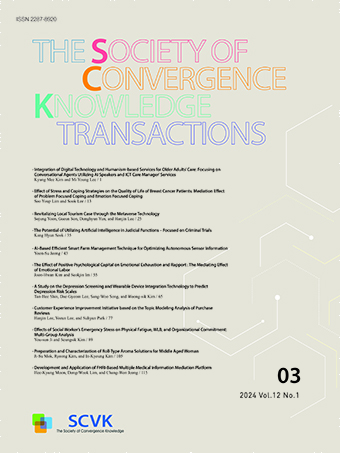Research Article
Abstract
References
Information
자외선으로부터 피부를 보호하는 데 중요한 자외선차단 제품 중 최근에는 선 스틱 제형의 소비량이 증가하고 있다. 개발한 선 스틱의 안정성을 평가하기 위해 보관 온도 조건을 다르게 하고 일광 조건에서 4주 보관 후에 선 스틱의 절단 강도와 자외선 흡수제의 함량을 분석하였다. 자외선 흡수제로는 Ethylhexylmethoxy cinnamate (Parsol MCX), Butyl methoxy dibenzoylmethane (Parsol 1789), Diethylaminohydroxybenzoylhexyl benzoate (Uvinul A Plus), Ethylhexyl Salicylate (Escalol 587), Octocrylene (Uvinul N539T))을 사용했다. 이들 자외선흡수제 5종을 가스크로마토그래피법(GC)을 이용하여 동시에 정량분석법을 확립 하였다. GC 분석법을 이용하여 자외선흡수제의 안정성 평가 결과 제품에서 자외선흡수제의 회수율이 적정범위 90~110% 이었다. 절단 강도 측정 결과, 온도변화에 따른 절단강도 변화는 거의 없고 일광 조건하에 절단강도 변화가 크게 나타났으므로 직사광선을 피해서 제품을 보관해야 할 것이다.
Among the sunscreen products that are important for protecting the skin from Ultraviolet (UV) rays, consumption of sun stick formulation has increased recently. To evaluate the stability of the developed sun stick, the cutting strength of the sun stick and the content of the ultraviolet absorber were analyzed four weeks after storage, with different storage temperature and solar conditions. Ethylhexylmethoxy cinnamate (Parsol MCX), Butylmethoxy dibenzoylmethane (Parsol 1789), Diethylaminohydroxybenzoylhexyl benzoate (Uvinul A Plus), Ethylhexyl Salicylate (Escalol 587), Octocrylene (Uvinul N539T)) were used as ultraviolet absorber. The five ingredients of UV absorbers were simultaneously quantitatively analyzed using gas chromatography (GC). As a result of the stability evaluation of the sun absorbent using the GC analysis method, the recovery rate of the sun absorbent in the product was 90 to 110%. As a result of measuring the cutting strength, there is little change in cutting strength due to temperature change, and the change in cutting strength is large under sunlight, so the product should be stored away from direct sunlight.
- J. H. Park, J. P. Kim, J. A. Kim, K. W. Seo, E. S. Kim and J. M. Seo "Survey of Preservatives and UV Filter Ingredients of Distributed Sunblock Products in Koreas", J. Soc. Cosmet. Sci. Korea, Vol. 43, No. 4, pp. 381-390, 2017.
- Food and Drug Administration and Health and Human Services. "Sunscreeen drug products for over the counter human use: final monograph. Final rule," Fed Regist., 64, 27666, 1999.
- Y. H, Lee, and J. C. Yang, "Simultaneous determination of sunscreen agents in cosmetics by HPLC", J. of Korean oil chemists' Soc., 29(4), 577, 2012.https://doi.org/10.12925/jkocs.2012.29.4.577
- T. Felix, "Simultaneous Determination of Water-soluble and Oil-soluble UV- filters by High-performance Liquid Chromatography.", Analytica Chimica Acta, 371, 1998.
- G. Potard, "Quantitative HPLC Analysis of Sunscreens and Caffeine During in Vitro Percutaneous Penetration Studies." International Journal of Pharmaceutics, 189, 1999.https://doi.org/10.1016/S0378-5173(99)00258-6
- C. G. Smyrniotakis, "Development and Validation of a Non-aqueous Reversed-phase High-performance Liquid Chromatographic Method for the Determination of Four Chemical UV Filters in Suncare Formulations." Journal of Chromatography A, 1031, 2004.https://doi.org/10.1016/j.chroma.2003.08.078PMid:15058600
- A. Nieto, "Determination of Personal Care Products in Sewage Sludge by Pressurized Liquid Extraction and Ultra High Performance Liquid Chromatography-Tandem Mass Spectrometry." Journal of Chromatography A, 1216, 2009.https://doi.org/10.1016/j.chroma.2009.05.061PMid:19539941
- A. Salvador, "Sunscreen Analysis: A Critical Survey on UV Filters Determination." Analytica Chimica Acta, 537, 2005.https://doi.org/10.1016/j.aca.2005.01.055
- Korea Food & Drug Administration, "Rule on Evaluate of Fungtionality Cosmetics" Notification No. 2012-59unit, 2012.
- J. H. Park, J. P. Kim, J. A. Kim, K. W. Seo, E. S. Kim, and J. M. Seo, "Survey of preservatives and UV filter ingredients of distributed sunblock products in korea." J. Soc. Cosmet. Sci. Korea, Vol. 43, No. 4, 381-390, 2017.
- Yousef Agha N, Haidar S, Al-Khayat M.A, "Development and Validation of RP-HPLC Method for Analysis of Four UV Filters in Sunscreen Products." Int. J. Pharm. Sci. Rev. Res., 23(2), No. 43, 254-258, 2013.
- Wharton M, Geary M, O'Connor N, Murphy B, A rapid High Performance Liquid Chromatographic (HPLC) method for the simultaneous determination of seven UV filters found in sunscreen and cosmetics, Int J Cosmet Sci., 33(2), 164-70, 2011.https://doi.org/10.1111/j.1468-2494.2010.00607.xPMid:20807259
- Yao X, Zheng X, Qin X, Qi Q, Determination of sunscreen agents in cosmetic products by reversed-phase high performance liquid chromatography, Se Pu., 16(3), 223-225, 1998.
- Nyeborg M, Pissavini M, Lemasson Y, Doucet O, "Validation of HPLC method for the simultaneous and quantitative determination of 12 UV-filters in cosmetics.", Int J Cosmet. Sci., 32(1), 47-53, 2010.https://doi.org/10.1111/j.1468-2494.2009.00544.xPMid:20412202
- Simeoni S, Tursilli R, Bianchi A, Scalia S, "Assay of common sunscreen agents in suncare products by high-performance liquid chromatography on a cyanopropyl-bonded silica column.", J Pharm Biomed Anal, 38(2), 250-255, 2005.https://doi.org/10.1016/j.jpba.2004.12.021PMid:15925215
- Kedor-Hackmann ER, De Lourdes Pérez González ML, Singh AK, Santoro MI, "Validation of a HPLC method for simultaneous determination of five sunscreens in lotion preparation.", Int J Cosmet Sci., 28(3), 219-224, 2006.https://doi.org/10.1111/j.1467-2494.2006.00313.xPMid:18489278
- Publisher :The Society of Convergence Knowledge
- Publisher(Ko) :융복합지식학회
- Journal Title :The Society of Convergence Knowledge Transactions
- Journal Title(Ko) :융복합지식학회논문지
- Volume : 8
- No :4
- Pages :39-48
- DOI :https://doi.org/10.22716/sckt.2020.8.4.034




 The Society of Convergence Knowledge Transactions
The Society of Convergence Knowledge Transactions







